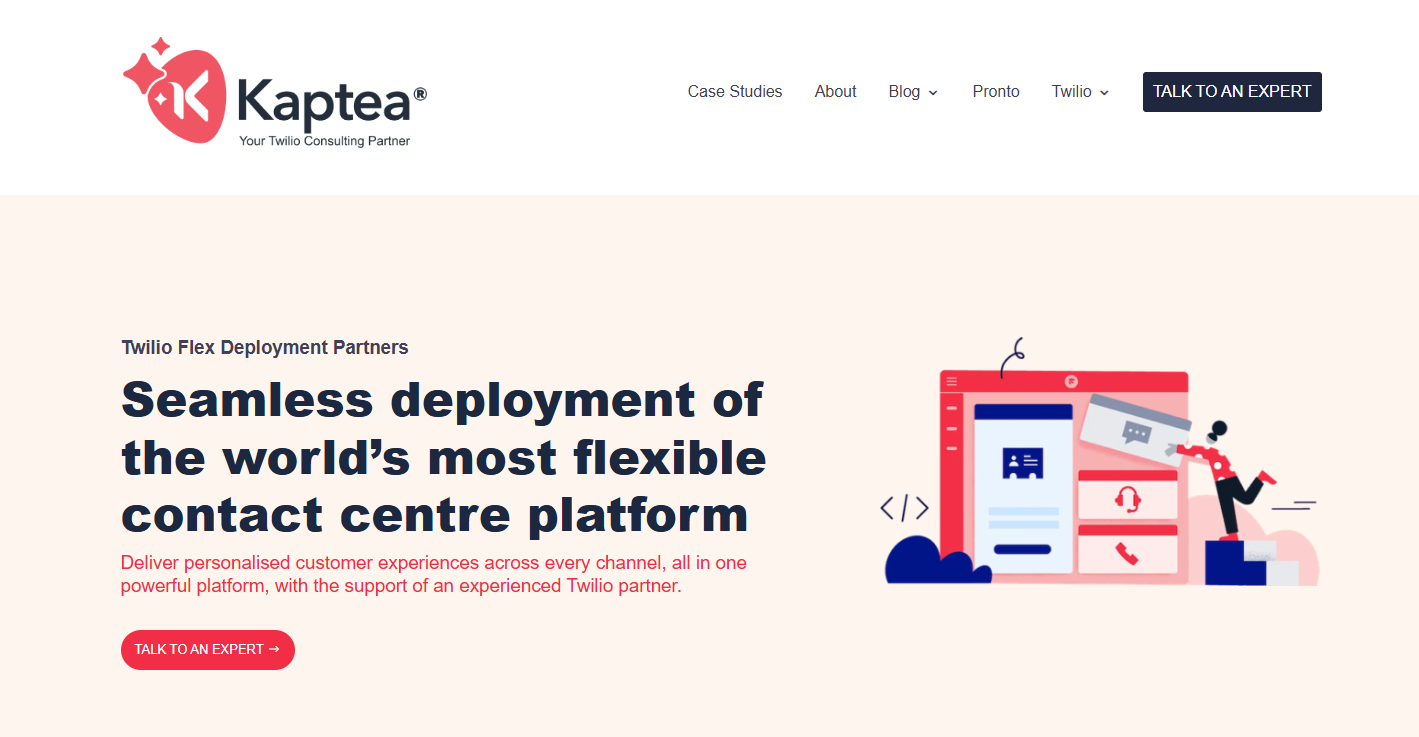
Customers move fast; your business needs to move with them.Real-time customer engagement isn’t a luxury - it’s a basic expectation. People want answers right away, help without delays, and interactions that feel personal and smooth. When you meet them where they are, in the moment they need you, everything changes.In this guide, we’ll break down what real-time engagement really means, why it’s important for business success, and how you can use it to keep customers happy, loyal, and coming back.You’ll get practical strategies you can actually use, from chatbots and live support to smart emails and social media replies. You’ll see how all of this connects to one goal: making customers feel like your business is ready for them, anytime, anywhere.Whether you're a startup or scaling fast, real-time engagement plays a major role in customer loyalty. Let’s take a look at how it works and how to get it right.
Real-time customer engagement means connecting with people the moment they interact with your business, whether that’s on your website, app, or social media. It’s about being there when someone’s interest is fresh.Let’s say a customer is browsing your pricing page. A chatbot pops up asking if they have questions. That’s real-time. Or, if someone abandons their cart and they get a quick push notification with a reminder and discount. That’s real-time, too.The goal is to remove delays and give people what they need when they need it. Instead of waiting for a support email or searching through a help page, they get a direct and helpful response right away.It’s simple: the faster you engage, the smoother the experience.
People expect fast responses. They’re used to instant everything - search results, messages, updates. So when they reach out to your business and hit a delay, frustration builds fast.Real-time engagement helps prevent that. It keeps things moving, builds trust, and makes it easier for customers to stick with you. Here’s why it matters:
When a customer is ready to act - ask a question, make a purchase, or request a quote - they’re in decision mode. That window is short. The longer they wait, the more likely they are to move on, forget, or look elsewhere. Real-time engagement steps in before that moment slips away.According to research from Velocify, responding to a lead within one minute can boost conversion rates by up to 391%. That’s not a small bump; that’s a major shift. It shows that even a few extra seconds of delay can make or break a deal.Think about it. If someone’s browsing your service, then messages your team and gets an instant reply, they’re far more likely to stick around. That quick response builds momentum and keeps the conversation going. It shows you’re available, attentive, and ready to help.
When customers get a fast response, it tells them you’re on top of things. They don’t have to chase you down or wonder if anyone’s listening. That alone builds a sense of trust. People want to know they’re dealing with a business that pays attention, not just when there’s a sale, but every time they reach out.Even small moments matter. A quick reply to a simple question, an update when something changes, or a friendly check-in after a purchase - these all add up. They show consistency and care.And here’s the thing: customers remember how you made them feel. If they felt ignored or left hanging, that sticks. But if they feel heard and supported, they’re more likely to come back and recommend you to others.Being responsive isn’t just good service. It’s a signal that your business is dependable. That kind of confidence is hard to beat.
No one enjoys waiting on hold or going back and forth over email for simple questions. Real-time engagement removes that friction. A quick chat or instant reply feels like a conversation, not a ticket number.When support happens in the moment, it feels more human. The interaction is smoother, the tone is relaxed, and there’s no need to repeat information to multiple people. That makes it easier for the customer and less stressful for your team.Customers expect this level of support now. They want fast answers, but they also want to feel like someone’s genuinely listening. When they get that kind of response, they don’t just get their issue solved; they walk away with a better impression of your business.This kind of interaction supports more than just the moment - it feeds into customer success. It keeps people moving forward, reduces frustration, and builds trust.
Customers don’t always leave because of major problems. Often, it’s the small frustrations like getting confused during checkout, not understanding a charge, or missing a feature they thought was there. If they can’t get help quickly, they move on, and many won’t bother coming back.Real-time support helps you catch those moments before they turn into cancellations or bad customer comments.Take this example: a customer tries to upgrade their plan but runs into a technical error. If they’re left to figure it out alone, they may cancel out of frustration. But if a live chat pops up and solves the issue in seconds, there’s a good chance they’ll follow through and stay.These fast fixes don’t just solve problems - they protect revenue. Keeping a customer from churning means protecting their customer lifetime value, not just today’s transaction.The more you respond in real time, the more chances you have to keep customers happy and loyal. And over time, those small moments become the reason they choose to stick with you.
There’s no single way to do real-time engagement - it depends on your customers, your tools, and how you prefer to connect. The goal is simple: respond while the customer is still active and interested.Below are some practical ways to do that across different channels and touchpoints.
One of the simplest ways to create real-time, personalized customer engagement is by setting up automated messages based on what your customers do. These are quick responses that feel personal even though your system handles them.Instead of guessing when to reach out, you let behavior and customer data guide the timing.Here are a few common examples:
These messages don’t just react; they guide. They help customers take the next step, answer questions before they’re asked, and show that your business is paying attention.It’s a simple way to add speed and relevance to your communication without making your team work overtime.
AI-powered chatbots help you stay available around the clock without stretching your team. They can answer common questions and even help with basic troubleshooting. The best part? They respond instantly, no matter the time of day.When someone visits your site and has a question, they don’t want to wait. A smart chatbot can step in right away, offer a helpful response, and keep the conversation going. If the issue is more complex, the bot can pass the customer to a human agent without losing context.This kind of instant support feels seamless and saves time for both the customer and your team. It also helps reduce repetitive tasks, so your support staff can focus on conversations that actually need a personal touch.

Sometimes, customers just want to talk to a real person, especially when their question is specific or the issue feels urgent. Live chat gives them that option without making them sit on hold or wait hours for an email reply.It’s quicker than email and more personal than a bot. When used well, it becomes one of the most effective customer engagement strategies you can offer. It removes friction and adds support exactly where it’s needed.Here’s where live chat really works:
Live chat helps you connect when the customer is already engaged and likely to take action. It also supports customer retention by showing that you’re responsive and easy to reach.Your team can manage multiple chats at once, which saves time without sacrificing quality. And when people get the answers they need without hassle, they’re more likely to continue their customer journey with you.
Your customers are already on social media - scrolling, posting, and tagging brands. If they’re talking about you and you’re not responding, that’s a missed opportunity. Social platforms give you a direct, public way to connect with people in real time.Let’s say someone tags your business with a complaint. If you reply quickly and respectfully, you show everyone watching that your team takes customer concerns seriously. That kind of interaction builds trust - not just with the person you helped but with everyone else reading the thread.It’s not all about complaints, either. Customers also share positive experiences, ask questions in comments, or send DMs looking for more info. Responding quickly makes your business feel approachable and reliable.Here’s the key: don’t treat social media as just a marketing channel. Treat it like a customer service desk with a friendly voice. Monitor mentions, keep an eye on comments, and reply like a real person, not a copy-paste script.
Push notifications are a simple way to reach customers directly, whether they’re using your app or browsing on a desktop.When used the right way, they’re quick, helpful, and can drive real action. But timing and relevance are everything. Send too many, or send the wrong kind, and people will turn them off.Here’s how to make them useful:
Push notifications work best when they feel personal and timely. The message should be clear, short, and relevant to the user’s recent activity.For example, if someone browses a product but doesn’t buy it, sending a quick follow-up with a discount can bring them back. If they’re waiting on a delivery, a status update builds confidence.Done right, push notifications aren’t a distraction - they’re a helpful tap on the shoulder at just the right moment.

Not every customer wants to start a chat or make a call. Sometimes, they’d rather solve the issue themselves and move on. Giving people the tools to find answers quickly helps reduce support tickets and makes the experience smoother for everyone.Here are a few useful options to offer:
These tools give people the freedom to get what they need without delay. They also free up your team to focus on more complex requests.
Email may not feel instant, but when it’s triggered by customer behavior, it becomes a powerful real-time tool. The key is to send messages that match what someone just did, like signing up, browsing a product, or leaving items in their cart.Instead of sending the same email to everyone on your list, focus on timing and context. For example, if a user signs up but doesn’t complete their profile, you can send a short follow-up the next day with a link to finish setting up their account. It’s not pushy; it’s helpful.These kinds of real-time emails feel personal and relevant. They keep the conversation going and gently guide the customer toward the next step. A well-timed email can bring someone back to your site, help close a sale, or remind them about a feature they haven’t tried yet.It also shows that your business is paying attention. When customers see you’re following up based on their actions, they’re more likely to stay engaged and more likely to convert.
You don’t have to post everything in real time to stay connected with your audience. In fact, planning and scheduling your social media posts ahead of time gives you more space to actually talk to people instead of constantly figuring out what to say next.Think of it this way: if you already have your weekly posts lined up, you’re not stuck trying to come up with a caption in the middle of your busiest day. That gives you more room to reply to comments, answer DMs, and jump into real conversations as they happen.Let’s say you’re launching a new product next Friday. You can prep posts in advance to announce it, share behind-the-scenes photos, and remind people when it drops. That content runs automatically while you stay available to respond in real time when customers start asking questions.Scheduling isn’t about removing the human side - it’s about keeping things organized so you can be more present when it counts. You’ll have a stronger social presence and more time to focus on what matters: real conversations with real people.
Customers don’t just stick to one channel. One day, they’ll email you, the next they’ll DM you on social, and later they might call. If those customer interactions don’t connect, they’ll have to repeat themselves, and that’s frustrating.An omnichannel customer experience brings everything together. It keeps your conversations consistent across email, SMS, live chat, voice, and social media so that customers don’t feel like they’re starting from scratch every time they reach out.Here’s what a strong omnichannel setup can do:
Platforms like Twilio make it easier to manage this kind of setup by connecting different channels into one system. So, whether your customer starts with a text and ends with a phone call, the experience stays seamless.It’s not just about being available everywhere - it’s about making each interaction feel like part of the same conversation. That’s what keeps people coming back.
Real-time engagement isn’t just about having the right tools - it’s about making those tools work the way you need them to. Twilio gives you a powerful platform, but getting it set up correctly and running smoothly can get complicated fast.That’s where a lot of businesses get stuck.Kaptea helps you skip the frustration. We don’t just hand over the tech; we configure it to fit your team, your workflows, and your goals. You’ll be able to talk to customers on any channel (WhatsApp, SMS, voice, email) and do it without glitches, delays, or confusion.

With Kaptea, you get more than a setup. You get support, guidance, and a team that knows what they’re doing.Here’s how we help:
If you're tired of systems that don’t talk to each other or customer service that feels clunky, it’s time to fix that.Talk to a Kaptea expert and start giving your customers the kind of experience they expect.
It’s the process of interacting with customers the moment they take action, like visiting your site, asking a question, or showing interest in a product. Using real-time data, businesses can respond instantly through chat, notifications, or personalized messages, creating a smoother, more relevant experience.
The 4 P’s often refer to:
These elements help build stronger relationships and reduce drop-off at key points in the customer journey.
The 3 C’s usually stand for:
A customer is about to leave your website after filling a cart. Seconds later, they get a pop-up with a discount or an offer to chat. That immediate response, based on their behavior, is a real-time interaction.